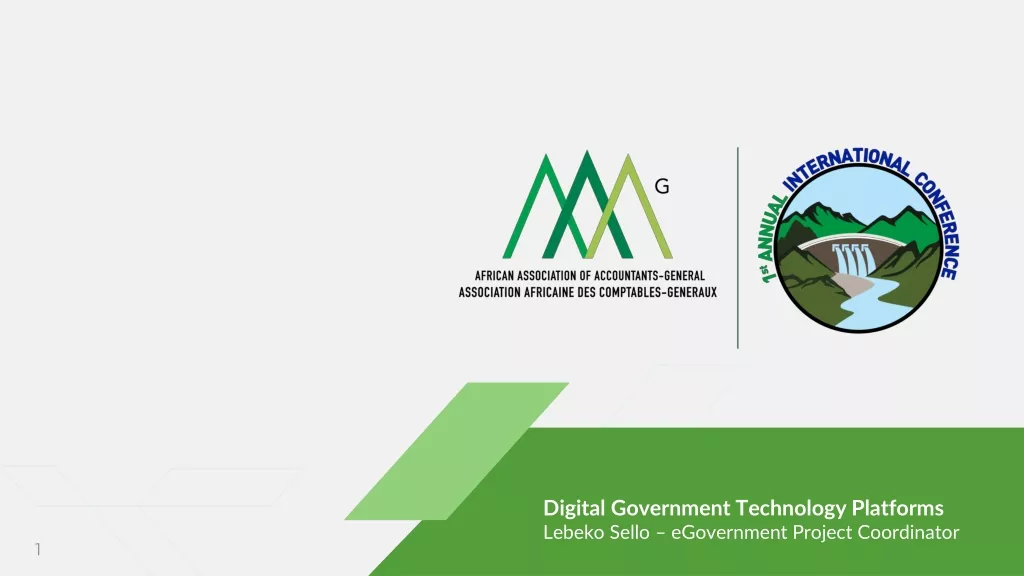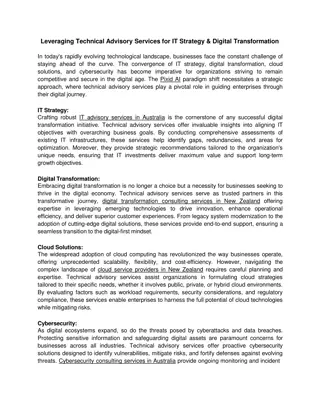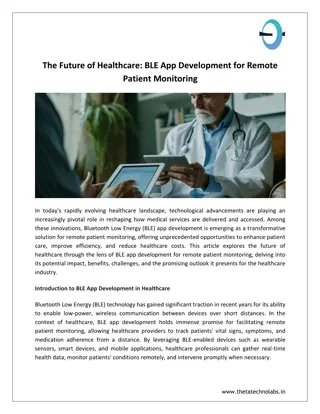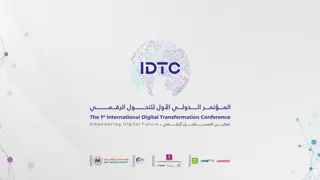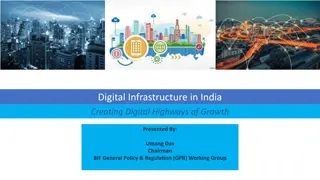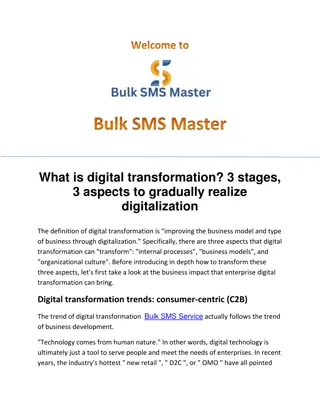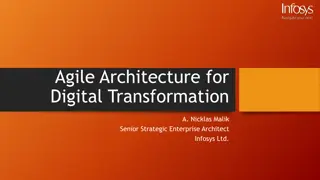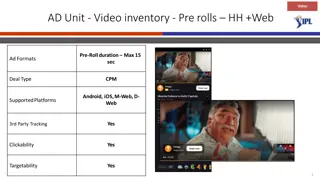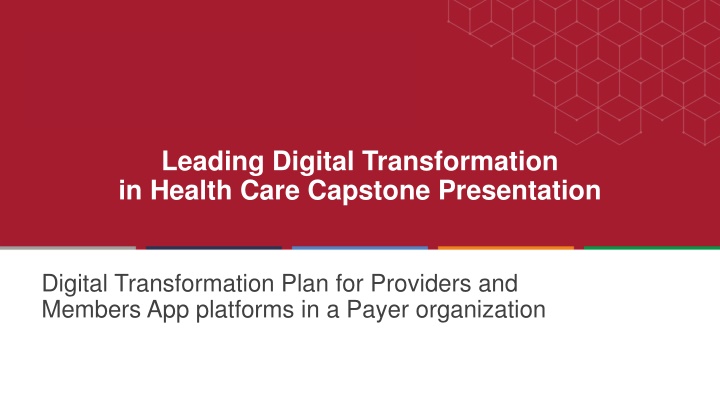
Leading Digital Transformation in Healthcare: App Platforms Evolution Plan
The digital transformation plan aims to enhance providers and members' platform by prioritizing functionalities for better adoption and integration, focusing on evolving to a value-based model, and leveraging technologies like Big Data, AI, and Telehealth to improve care coordination effectively.
Download Presentation

Please find below an Image/Link to download the presentation.
The content on the website is provided AS IS for your information and personal use only. It may not be sold, licensed, or shared on other websites without obtaining consent from the author. If you encounter any issues during the download, it is possible that the publisher has removed the file from their server.
You are allowed to download the files provided on this website for personal or commercial use, subject to the condition that they are used lawfully. All files are the property of their respective owners.
The content on the website is provided AS IS for your information and personal use only. It may not be sold, licensed, or shared on other websites without obtaining consent from the author.
E N D
Presentation Transcript
Leading Digital Transformation in Health Care Capstone Presentation Digital Transformation Plan for Providers and Members App platforms in a Payer organization
Introduction Healthcare industry has evolved during the pandemic demanding better technologies, access to care and quality. To succeed delivering these demands we need to leverage to technology, transform the way we do business creating robust plans and engaging in a different way of viewing and doing things, the transformation culture. My digital transformation plan is targeted to an IT organization within a Healthcare company (Payer and Clinics) looking forward to 2030. An existing providers and members platform evolution that provides digital tools to enhance continuous medical care, quality, accessibility. This platform is mostly developed inhouse and it is costly. There is a need of making it profitable for the company avoiding the cost burden.
Goals In our journey through the digital transformation, we want to achieve the following goals: Making the tool a leading one, from a service convert it to a product, offering functionalities suitable for adoption, integrating into the practice workflow and enhance it. For the Members App prioritize functionalities that promote wellbeing and advocate self-service. Evolve to a value-based model improving the quality of service Solutions should strive to improve care coordination in cost effective manner.
Technology Foundations Technologies and technology foundations that are important contributors to the transformation are Big Data and Cloud, AI, Interoperability, Telehealth Interoperability continue the journey to reach a high-tech maturity. This have been the starting point in our z transformation. While not yet applied and are in the discovery and setting the strategy phase the following will be part of our transformation each with a separate Roadmap to ensure that is completed in phases. Big data and Analytics go hand in hand as foundation to AI. Reports and predictive analytics will enhance the provider workflow. Data availability will provide a way to migrate with easier adoption to a value-based model. Continue to transform and develop our homepage using Big Data, using all the data available to create predictive analytics improving providers workflow Using AI based chats can help reduce calls to Call Center, generative AI to have the ability to interpret unstructured medical data facilitating analysis. Improve medical adherence
Change Management Executive Committee (CMO, CFO, COO, CIO, CDO) Digital Transformation Board Plan Operations PMO Clinics BTS Finance Quality The diagram above show the basic approach to governance. Transformation priorities will come from the decisions and assessments evaluated by the Transformation Board. Initiatives will be prioritized based on impact, effort and cost. They will be set through a 5-to-10-year roadmap. Once the priorities per year and multiyear are selected, tracks will be recommended to the executive and steering committee for confirmation and approval and request of Funds
Change Management Implementing the transformation will be main responsibility of the IT department guided by the Business Improvement team (similar to PMO) using the guidelines of architecture, infrastructure , cybersecurity and healthcare regulations. Governance tools from BOI will apply to the effective management and accomplishments of goals ensuring the adoption and operations after completion. Each local team (will be assigned per track) will have responsibilities depending on the involvement and impact level to the business. Central teams will gather results, metrics, status from each time and align them all together so they can be discussed with the board and executive committee. Project Management team will be a liaison between the central and local authorities. Budget for the digital transformation will be set as part of the prioritization. Roadmaps per technology are been set and each will have its budget related to set priorities. Revision and assignments will be done in an annual basis so it can be adjusted to the reality and achievements of the previous years. An additional bucket of innovation should be created for demos, R&D, trial and errors to reduce the failure rate and scale up from pilots and trials.
Iterative Innovation When designing the Strategic priorities one of the is Technology Enhancements/transformation through Innovation. Having this set as a corporate priority helps to share the vision for all groups so part of the weight of their initiatives are aligned to this objective. An example if it is EHR integration with our platform so we can offer one centralized solution to the provider converting their workflow in a simple one. As part of the budget a bucket for experimenting is been set, this will allow for trials that can become projects/initiatives that will result in innovation. Continuously working with change management so the culture is maintained as understand in a way that drives adoption and ultimately have a result of value. Resources must be trained and develop constantly and a strategy to maintain the core key teams are important. Having capacity and retaining resources is a challenge that we face everyday and maybe transforming also the current staff augmentation model from vendors to a more in house one, would secure the talent pool.
Successful Partnerships An important part of the strategy and maintaining the culture is to create successful partnership. To accomplish this we should evaluate and determine the 5 major pain points and work iteratively to keep identifying them ans they will evolve through time. This pain points can be identified through questionnaires, surveys, focus group, shadowing's and offsites with cross functional groups. Evaluation of vendors, inclusion of medical services including ancillaries, nurses etc, government liaisons and members is imperative to create an effective and robust solution that will help mitigate and solve the pain points making the implementation a less disruptive experience.
Developing a Business Case For my business plan what we need to do first is to build the strategy, review it with as many stakeholders as possible in order to have a robust plan. Assessment of required skills and resources as a result of the agreed plan must be done. Build the team. Evaluate ballpark efforts estimates, prior experiences to create a high-level timeline of deliverables. Business case must also include project justification, impact, dependencies, establish what type of solutions will be implemented, benefit analysis that includes the tangible and intangible benefits per areas, some examples include examples cost reduction, competitive advantage, membership growth, quality of care. Look for solutions outside, list dependencies external vendors. Address risks with a mitigation plan for each this will confirm the viability of the business case and plan. Establish success metrics Technology considerations assumptions and constraints should be identified as aprt of the strategy and solution to be implemented.
Digital Culture To develop and maintain the digital culture Change Management and continuous training approaches are some key elements. These trainings held and modified after assessments on the phase of the transformation are completed. This can help evaluate what targets have been made, if changes or added effort is needed and what can be implemented next so the engagement through all the business unit and consumers is maintained. Ensuring the right governance and management through all the phases with the support of C level executives continuing the support even after go live. Governance must include engagement through all levels in the organization to ensure the vision and mission are shared. Celebrating the achievements after targets are reached. The product is being commercialized so long-term plan should be followed and readdressed every time is measured so ROI and investment is sustainable. An additional funding for risks and R&D should be in place to pilot new strategies. Promoting and creating plans for adoption is necessary lead by a Transformation team that are held accountable of driving the transformation for success. .
Value Realized For the realization of value, the approach suggested will be to evaluate all the technologies and ititiatives in separate roadmaps. These Roadmaps will use a scoring system of 1 to 5 to identify which functionalities are more important for leadership. Business should evaluate and submit value added metric so executives can learn more of what it is expected and weight against the transformation scoring. Once this realization of value is addressed then it will be taken to senior executives to ensure engagement and funding. Surveys and success evaluation including the experience of middle management groups is necessary to keep the focus on measurement, track baseline established, and revisit metrics and value assessment once evaluated.
Summary In summary these are key takeaways when building your transformation plan: Creation of a framework analysing success factors and transformation strategy Establish a governance to ensure implementation, digital culture enfasis Strategy should be created around the enabling technologies as AI, Interoperability, Tele Health, Big Data, Block Chain. Build a robust and strong business case is key to a successful transformation Create success partnerships and identify the pain points Ensure value is measured throughout all the stages of the transformation Iterate
References Leading Digital Transformation in Healthcare Modules and material from emeritus.org
Thank You Maria Soto Rivera


